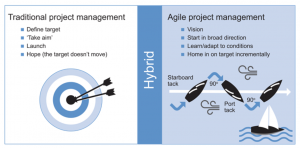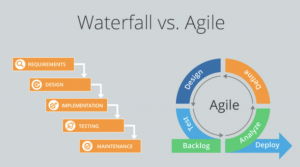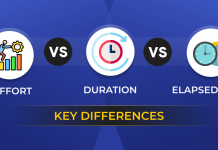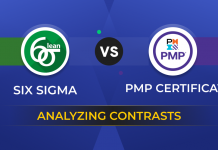
Today, along with project management methodology, we also see the Agile methodology in practice to deliver products. According to PwC’s ‘Insights and Trends: Current Portfolio, Programme, and Project Management Practices’ 2017, most organizations that employ an Agile Project Management methodology contribute the use of Agile towards project success (59%), project efficiency (59%), and enabling business performance goals (49%) over organizations that do not implement Agile methodology. It is interesting to see that project management and Agile complement each other in terms of the processes involved in completing a project.
The principles of project management cover the entire lifecycle of developing a product: planning, building effective teams, communication, and monitoring progress. But, the role of the project manager is also evolving and aligning with key agile concepts of integrated, self-directing teams in which team members take responsibility for managing their tasks and commitments.
Successful project management does not merely involve completing on time and adhering to budget constraints, but also delivering the project with benefits. According to survey results by “Project Management Institute”, nearly more than half(54%) of organizations worldwide are completely aware of the values and importance of project management principles.
Project management methodologies have proven to be a successful element in handling an organization’s efficiency. Enterprises adopting project management techniques make the projects successful 2.5 times more than those who don’t use and the wastage of resources reduces to 28%.
To understand how project management guidance helps in agile development environments, first, we need to understand what Agile is and how it is helping in delivering smart software products to the market.
What is Agile?
Agile is an iterative technique to deliver a project throughout the project lifecycle. The project is broken into various stages and also involves collaboration with stakeholders. The Agile process begins with clients describing how the end product should be and the purpose of developing it. This provides clarity on the customer requirements to the project team. Incorporating continuous collaboration is the major key amongst team members and the project stakeholders to make informed decisions.
While Agile has some processes which are similar to project management, it tends to move away from traditional project management processes. Agile approaches are mainly used in software development to help businesses respond to unpredictability.
Agile mainly came into existence when traditional approaches to managing software development were failing on a regular basis. To cut down on this, industry experts developed an Agile manifesto that proposes four important values, which even today are relevant while developing software as a product.
- Individual interactions over processes and tools
- A working product over comprehensive documentation
- Collaborating with customers rather than indulging in contract negotiation
- Respond to business change rather than following a plan
How Agile methodology is Different?
In the traditional Waterfall approach, products were produced in the form of an assembly line, where the tasks were repetitive and each component went only after a particular work was completed in sequential phases. It was a phase-based approach where developers first gather the project’s requirements, then complete its architecture and design, then write the code, and so on. Here, there was a lack of communication between the groups who completed different phases of work.
Though the Waterfall method gives us the structure upon which to base our work, it fails to take in the changes happening outside the immediate business environment and chances are the product may become irrelevant when released in the market.
In an Agile development environment, teams have the luxury to stop and re-evaluate the direction of the project. Every aspect of development, in the form of requirements, design, architecture, and more is continually revisited every two weeks, to see if there is enough time to steer the project in another direction.
This inspecting and adapting at the same time reduces development costs and time to market. The team’s work cycle is just limited to two weeks. Stakeholders have the opportunity to fine-tune releases for success in the real world. Agile development helps organizations to build the right product. It allows a product to be as competitive as possible in the marketplace. Agile helps in ensuring a product’s critical market relevance.
Also go through the blog and understand what is Agile Product Development and its best practices!
Benefits of Blending Project Management with Agile Development Practices
The major role of a project manager who is competent in both project management methodologies and Agile is to remove obstacles that are in the team member’s way, including administrative or logistical issues.
An Agile Project Manager still has to produce plans, budgets, and key deliverables. Just because a project is Agile, it does not mean the fundamentals of project management are irrelevant. Agile is based on functions and delivery rather than guessing the sequence of tasks to produce the product. The planning is more based on the features and business value, with a focus on the vision for success.
A key characteristic of a project manager who is competent in both project management methodologies and Agile is his technical competence. He should know the business domain and the technology which is being used to deliver the product. The Agile project manager will work closely with the technical team and the business members to guide them to achieve the envisioned product.
As the private sector embraces the use of Agile methodology, many project managers are seeing the benefits of getting certified in both project management and Agile methodology. By enhancing their knowledge and capabilities, certified project and Agile managers can improve their contributions to their organizations and their market worth as well.
I hope you found my article interesting and informative. While you are here, do check out these other articles that might interest you.
















